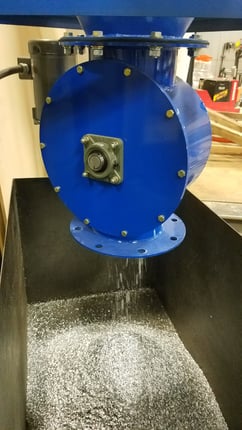Airlocks are required in order for dust collectors to operate correctly. When a dust collector is under positive pressure, the airlock prevents air and collected material from blowing out of the dust discharge flange. A lack of airlock will cause dust to be thrown into surrounding areas and pile up on the floor and other surfaces.
When a dust collector is under vacuum, an airlock prevents air from entering the dust collector from the dust discharge flange. If no airlock is installed, air will leak in through the dust discharge, re-entraining material from the hopper while lowering the airflow at the pickup points.
Which Type of Airlock You might Use
Every airlock will leak a certain amount of air into or out of the hopper depending on the conditions the hopper is under. Depending on your application, the amount of acceptable leakage might determine the type of airlock you use.
A knife gate has the greatest amount of leakage, because when the knife gate is open, there is no airlock, only when you close the knife gate will you achieve an airlock.
A rotary valve provides a good, steady airlock but in order for the rotor to turn, there must be a gap between the rotor and the housing. This gap allows air to constantly leak past the rotor. The rotary valve also will allow air pass if the pockets in the rotor are not fully filled with material.
The double dump valve provides one of the lowest leakage rates of an airlock. The double dump valve is similar to having two (2) knife gates in series. This creates a chamber between the two flap plates. At all times one of the flap plates is closed, so the total leakage in the double dump valve is the volume of the chamber minus the volume of the material in the chamber.
Aerodyne’s Vacu-Valve
Aerodyne also produces a Vacu-Valve, which provides low leakage. The Vacu-Valve can only be used on applications with a slight vacuum and must have material that is fine and free-flowing (doesn’t easily bridge). The Vacu-Valve has an opening that a rubber sleeve is attached to. This sleeve is pulled together by the vacuum in the hopper.
Material then begins to build up above the sleeve. As the material builds up, gravity and the weight of the material slowly trickles the material down through the sleeve and out of the system. This trickle action is dependent on many conditions, including the weight of the material, the amount of vacuum in the system, and the ease of the particles to flow through the sleeve (particle size, stickiness, etc.)
So when selecting an airlock for you dust collector, don’t forget to factor in the air leakage each airlock will allow.
To learn more about which dust collector, please contact our experts at 440-543-7400 or visit our website: www.dustcollectorhq.com.
To improve efficiency and safety, there is no substitute for an on-site inspection by an experienced expert. Click below to start with a free 20-minute phone consultation by clicking the button.

